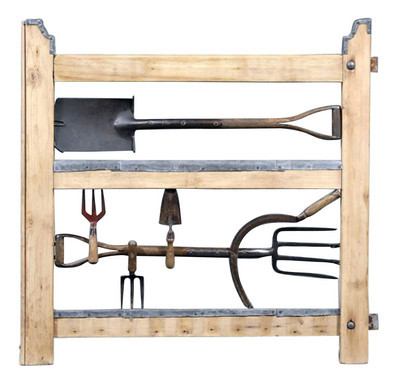The Kovels: ANTIQUES & COLLECTING
Folk art takes many forms, anything from cigar-store Indians to bottle-cap figures and carved coal pictures. It is the art of the untrained artist, and each piece is unique.
With spring comes thoughts of the garden and where to place antique urns, pots, statues, architectural tiles, fountains, sundials, bird feeders and other collected pieces. Fashionable gardens today often have gates or fences decorated with antiques. Old gardening equipment is popular.
Galvanized metal watering cans of the past have long spouts and large heads. Some European examples have brass heads. Old, rusty metal hand tools that can hang on a fence also are popular. Larger gardening tools like rakes, pitchforks and shovels can be put in the ground as if just left by a gardener or worked into a folk art gate or fence.
Brunk Auctions sold a garden gate made from a pine frame decorated with a vintage shovel, pitchfork, sickle, trowels and hand cultivator. The 48-by-49-inch gate made in the 20th century sold for $650.
Recycle your old tools or some you spot at a garage sale into a special folk art garden accent.
Q: I have a small table that converts into a desk. The table's single drawer holds a writing surface that lifts to reveal a storage section. Inside there's a sunken inkwell and a tray that can hold pens and pencils. There's also a gold seal inside that says "Cadillac Desk Table, Cadillac Cabinet Co., Detroit, Michigan." Four patent dates between 1906 and 1908 are also on the seal. Please tell me about the company.
A: The Cadillac Cabinet Co. was related to the Wolverine Manufacturing Co., both of Detroit. Cadillac desk-tables came in oak or mahogany and were advertised and sold widely in the early 1900s. The ads were directed primarily at women, who were encouraged to consider the piece a practical bedside table.
Cadillac desk-tables sell today for $150 to $500, depending on condition, style and type of wood.
Q: In the 1960s I collected a complete set of 36 dolls from the Reddi-Wip company. The 8-inch plastic dolls are dressed in the ethnic costumes of various countries. I contacted ConAgra, which now owns the brand, to get some information about the dolls, but no one there could help me.
I even have the original color order form, which pictures 30 dolls, and says you can get as many dolls as you want. For each doll, you had to send $1 plus the red lock tab from a Reddi-Wip can. I would like to know who made the dolls and what they're worth.
A: Reddi-Wip, a brand of whipping cream you squirt from a can, was invented in 1948. The brand went nationwide in 1954.
Reddi-Wip's "Dolls of the World" promotion started in 1965 and continued until at least 1976. Plastic 8-inch dolls were made by many companies in the 1950s and '60s, so if a maker's mark is not on the dolls, it's impossible to guess who made them.
Today, the dolls are not worth more than a few dollars each, but the whole set might bring a premium.
Q: I have a small, dark-red bitters bottle that's just 3 inches tall. It's embossed "A. Lancaster's Vegetable Jaundice Bitters, Col. Sam Johnson, Proprietor, Richmond, Va." The bottom is embossed "Wheaton, N.J." Is the bottle valuable?
A: Your bottle is a miniature reproduction made after 1970 by the Wheaton Co. of Millville, N.J. Wheaton made reproduction and fantasy flasks, decanters, bitters bottles and more for the gift-shop trade. Fortunately, Wheaton marked all the reproductions with its name.
Wheaton reproductions are collectible. Your bottle would sell today for $15 to $20.
Q: One of my souvenir spoons is a 4-inch sterling silver commemorative spade from the 1911 groundbreaking for the 1915 Panama Pacific International Exposition in San Francisco. The inscription on the blade of the shovel states: "Used by William Howard Taft, President of the United States, October 14th, 1911 in turning the first spadeful of earth for the Panama Pacific International Exposition to be held in San Francisco, 1915." I found a photo of the same souvenir on the Web site of the Palace of Fine Arts, one of the World's Fair buildings. Do you know how many of these little shovels were made and how much one is worth?
A: The Pan-Pacific Exposition was held to celebrate the opening of the Panama Canal, a boon to trade and travel to and from California. Shreve & Co., a well-known San Francisco silver manufacturer, made not only the real, full-size shovel Taft used, but also made the little gilded replica shovels to be sold as souvenirs.
They must have been popular and fairly plentiful, because they come up for sale regularly. Prices range from $35 to $70.
Ralph and Terry Kovel's column is syndicated by King Features. Write to: Kovels, (Las Vegas Review-Journal and Sun), King Features Syndicate, 888 Seventh Ave., New York, NY 10019.
0||296339.jpg||Ralph and Terry Kovel||






















